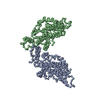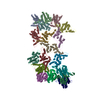+Search query
-Structure paper
| Title | VelcroVax: a "Bolt-On" Vaccine Platform for Glycoprotein Display. |
|---|---|
| Journal, issue, pages | mSphere, Vol. 8, Issue 1, Page e0056822, Year 2023 |
| Publish date | Feb 21, 2023 |
 Authors Authors | Natalie J Kingston / Keith Grehan / Joseph S Snowden / Mark Hassall / Jehad Alzahrani / Guido C Paesen / Lee Sherry / Connor Hayward / Amy Roe / Sam Stephen / Darren Tomlinson / Antra Zeltina / Katie J Doores / Neil A Ranson / Martin Stacey / Mark Page / Nicola J Rose / Thomas A Bowden / David J Rowlands / Nicola J Stonehouse /  |
| PubMed Abstract | Having varied approaches to the design and manufacture of vaccines is critical in being able to respond to worldwide needs and newly emerging pathogens. Virus-like particles (VLPs) form the basis of ...Having varied approaches to the design and manufacture of vaccines is critical in being able to respond to worldwide needs and newly emerging pathogens. Virus-like particles (VLPs) form the basis of two of the most successful licensed vaccines (against hepatitis B virus [HBV] and human papillomavirus). They are produced by recombinant expression of viral structural proteins, which assemble into immunogenic nanoparticles. VLPs can be modified to present unrelated antigens, and here we describe a universal "bolt-on" platform (termed VelcroVax) where the capturing VLP and the target antigen are produced separately. We utilize a modified HBV core (HBcAg) VLP with surface expression of a high-affinity binding sequence (Affimer) directed against a SUMO tag and use this to capture SUMO-tagged gp1 glycoprotein from the arenavirus Junín virus (JUNV). Using this model system, we have solved the first high-resolution structures of VelcroVax VLPs and shown that the VelcroVax-JUNV gp1 complex induces superior humoral immune responses compared to the noncomplexed viral protein. We propose that this system could be modified to present a range of antigens and therefore form the foundation of future rapid-response vaccination strategies. The hepatitis B core protein (HBc) forms noninfectious virus-like particles, which can be modified to present a capturing molecule, allowing suitably tagged antigens to be bound on their surface. This system can be adapted and provides the foundation for a universal "bolt-on" vaccine platform (termed VelcroVax) that can be easily and rapidly modified to generate nanoparticle vaccine candidates. |
 External links External links |  mSphere / mSphere /  PubMed:36719225 / PubMed:36719225 /  PubMed Central PubMed Central |
| Methods | EM (single particle) |
| Resolution | 2.9 - 3.6 Å |
| Structure data | EMDB-14866, PDB-7zq8: EMDB-14868, PDB-7zqa: |
| Source |
|
 Keywords Keywords |  VIRUS LIKE PARTICLE / VelcroVax / VIRUS LIKE PARTICLE / VelcroVax /  Hepatitis B virus / Hepatitis B core antigen / Hepatitis B virus / Hepatitis B core antigen /  Affimer / Affimer /  Vaccine / Recombinant / VLP / Antigen display Vaccine / Recombinant / VLP / Antigen display |
 Movie
Movie Controller
Controller Structure viewers
Structure viewers About Yorodumi Papers
About Yorodumi Papers







